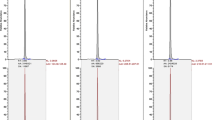Abstract.
Ketamine is an anaesthetic agent extensively used in intensive care patients, and it has proved its efficacy in the management of burned patients. In these patients, alterations in serum protein binding occur that may have significant clinical implications. Scarce data were observed in the literature about the binding of ketamine to human plasma proteins, and no data about the binding of its active metabolites, norketamine (NK) and dehydronorketamine (DHNK) were found. In this study, protein binding of ketamine, NK and DHNK in human serum were determined using the ultrafiltration technique. The percentage of drug bound to serum proteins at 30°C was found to be 69%, 60% and 50% for DHNK, ketamine and NK, respectively, while these percentages were 75%, 64% and 54% for DHNK, ketamine and NK respectively at 20°C. The binding of ketamine and its metabolites was independent of drug concentration.
Similar content being viewed by others
Author information
Authors and Affiliations
Additional information
Accepted in revised form: 28 January 2002
Electronic Publication
Rights and permissions
About this article
Cite this article
Hijazi, Y., Boulieu, R. Protein binding of ketamine and its active metabolites to human serum. Eur J Clin Pharmacol 58, 37–40 (2002). https://doi.org/10.1007/s00228-002-0439-4
Received:
Published:
Issue Date:
DOI: https://doi.org/10.1007/s00228-002-0439-4




